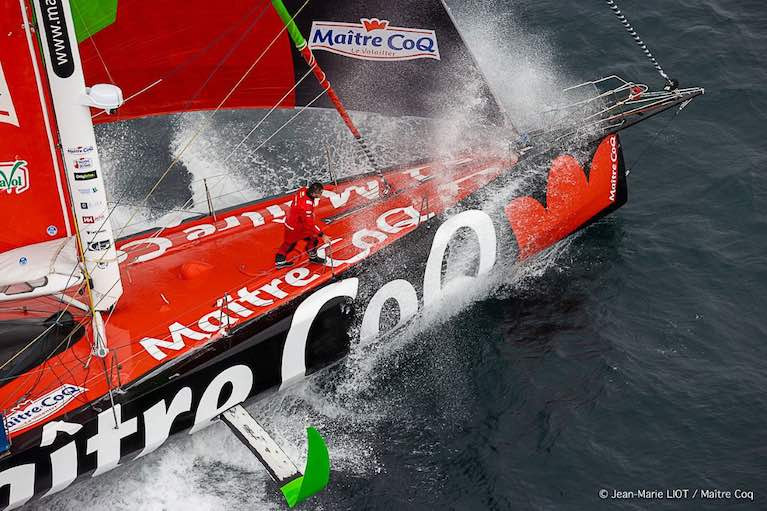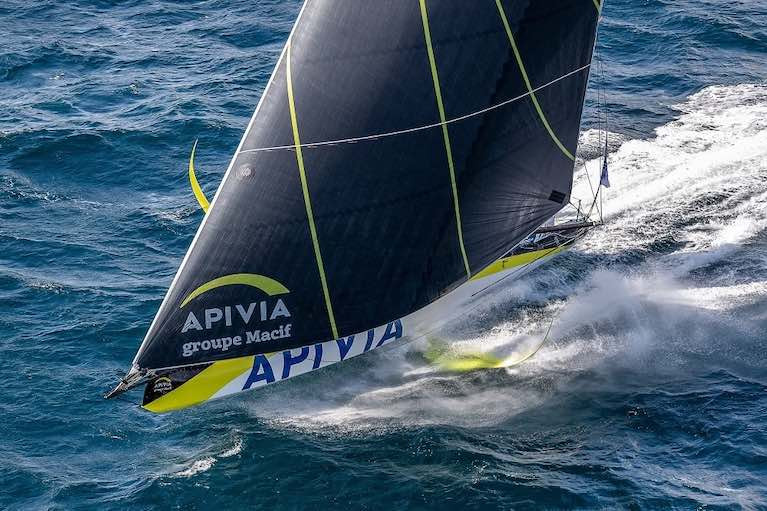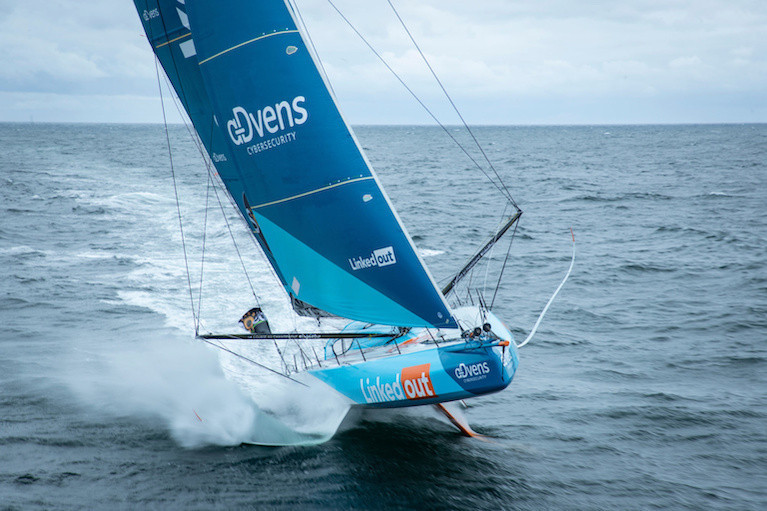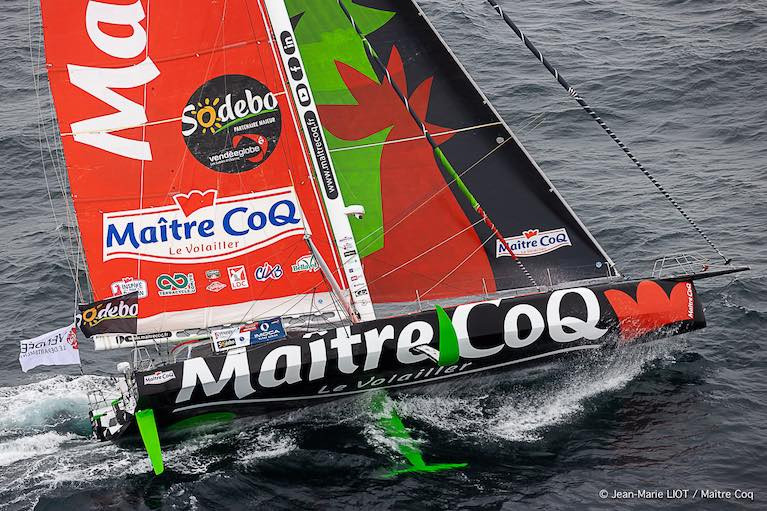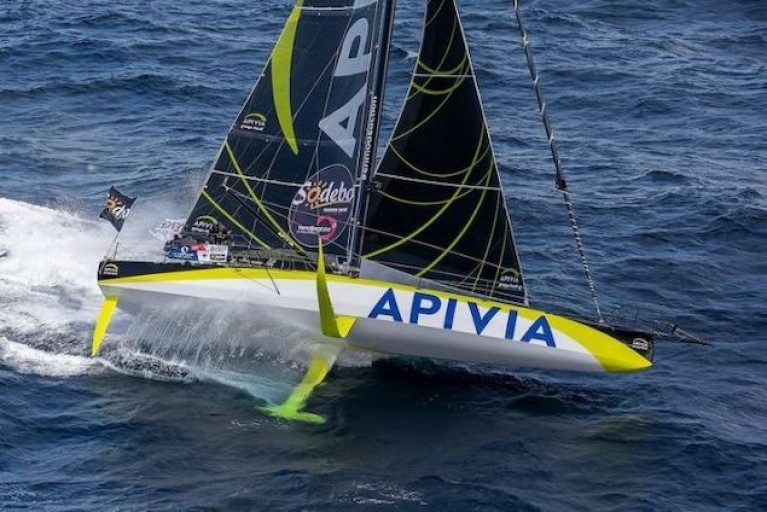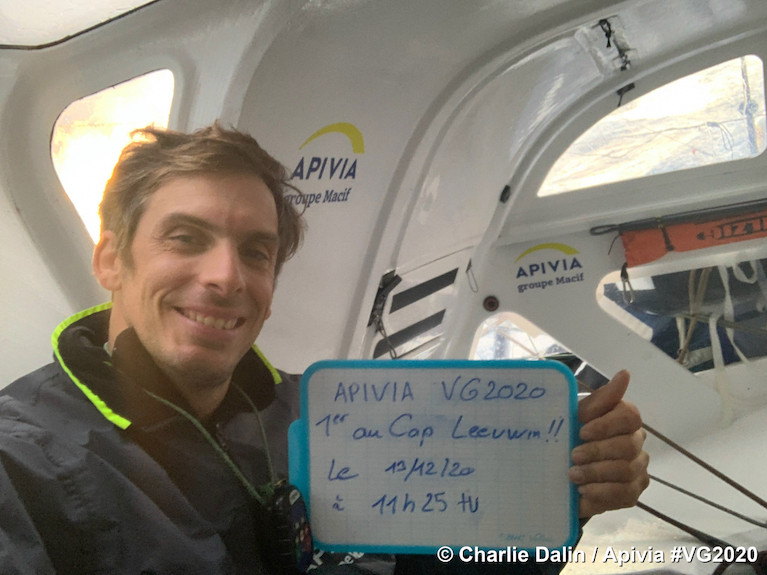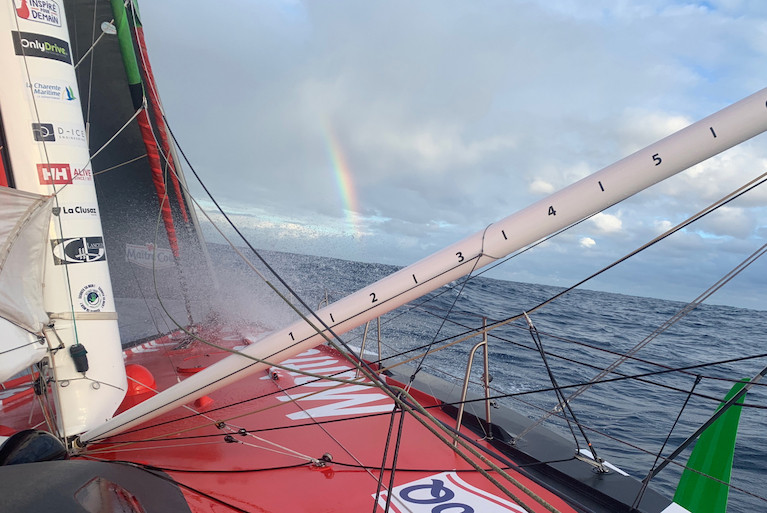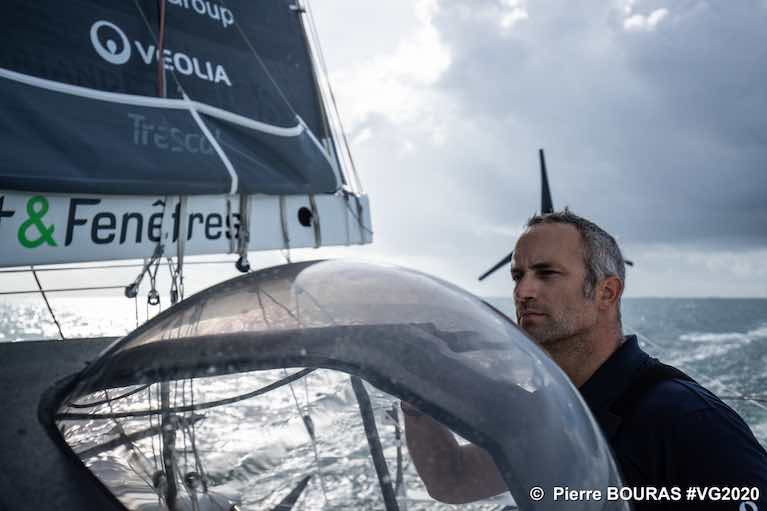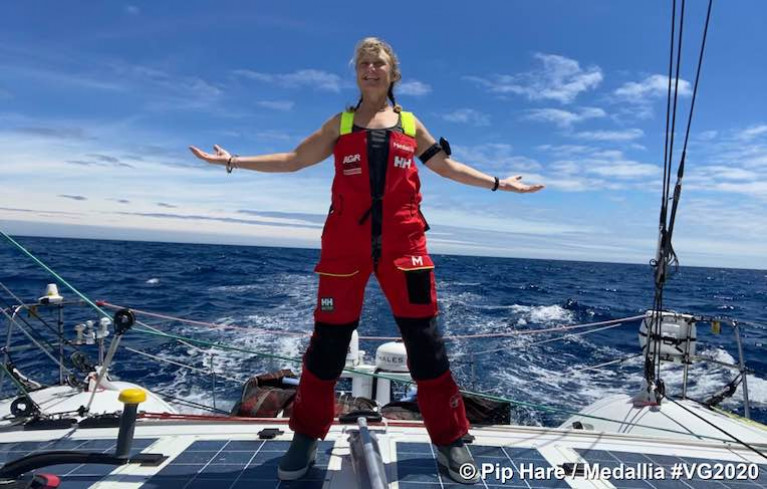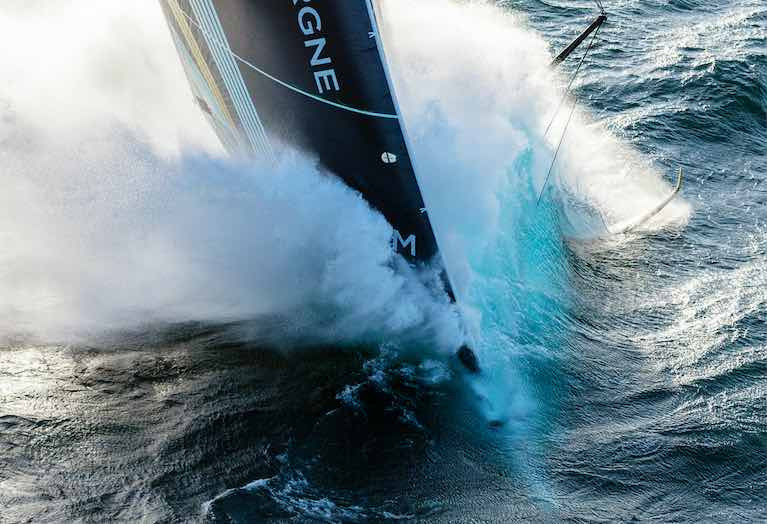Displaying items by tag: Vendee Globe
Yannick Bestaven in Maître CoQ IV Is New Leader of the Vendee Globe Race
Yannick Bestaven, skipper of Maître CoQ IV took the lead of the Vendée Globe early this morning. And though the 47-year-old from La Rochelle who is sailing a 2015 launched boat has threatened the lead before sailing an accomplished, express passage on his first time across the Indian Ocean, ‘Besta’ today becomes the 10th different leader on the 20th lead change on this remarkable Vendée Globe since the start in Les Sables d’Olonne back on Sunday 8th November.
Bestaven is now jousting with Thomas Ruyant as the pair scythe eastwards leaving the Indian Ocean behind and passing into the Pacific tonight, on a fast port gybe running as close to the Ice Exclusion Zone as they dare in the decidedly chilly Fifties. The leaders will also pass the midpoint of the 24410 nautical miles course this evening.
Bestaven and Ruyant are 15 nautical miles apart this evening. Earlier in the day they spoke on VHF radio. The LinkedOut skipper noted on the morning call that maybe Bestaven’s older generation VPLP-Verdier design might prove quicker as the 25 kts breeze moves aft to give more VMG downwind conditions. Meantime the Maître Coq IV skipper has continued to show high average speeds on what will be a long port gybe drag race for the next three days at least.
One hundred and forty miles behind them previous leader Charlie Dalin is back in the game after an exceptionally tough and exacting repair made to the foil bearing and housing on the port side of his APIVIA. Dalin told today how he worked steadily through a detailed plan including accurate drawings of the replacement carbon composite part he had to cut and replace into the foil housing, while suspending himself from a halyard.
Dalin explained, “The hardest part was fitting it. I was going back and forwards between the cockpit and the foil exit location on the hull I was suspended by a halyard to reach the point where I could fit the chock and I don’t know how many times I went back and forth, I don’t know 30 or 40 times to adjust the carbon piece to fit in the foil case. And in the end just before nightfall I managed to fit the piece in and tinker it. It was a big relief as I could see the sun going down. I was saying to myself ‘Charlie you really have to do this, you have to do this before it is dark because after that it is going to be too late. I worked really hard and managed to do it.”
Wearing a smile of relief he had admitted, “I have had a few problems. But this one puts the rest in perspective. Before a small problem felt big for me, a big concern, and after this one all my problems before they feel small. I am glad this one is over and I feel I have gained confidence in my ability in fixing the boat and I really hope the repair will hold. I now know what the Vendée Globe is about it is about surviving, managing to carry on with the boat. Boats tend to lose percentages of performance as you go on and the game is to lose fewer percentages than the opposition. So I hope I won't lose any more per cent from now.
Now I have to cross the biggest ocean in the world, the Pacific and in my line of sight is Cape Horn, it seems so far, far away, so many thousands of miles, but believe me I am glad the Indian Ocean is over soon.”
He concluded “I happy to do this and to still be in the race. I am only 150 nautical miles behind the leaders. It is not unachievable to come back, so I am here and I am back and I have them in my sights.”
Thomas Ruyant in Command of Vendee Globe Race, Dalin Completes Repairs
Having been slowed since around 1800hrs UTC yesterday evening to evaluate and then today to make some kind of repair to his port side foil system of APIVIA, one-time Vendee Globe leader Charlie Dalin has dropped to third and lost over 120 miles to his two nearest rivals Thomas Ruyant and Yannick Bestaven. But Dalin, Vendée Globe leader for 23 days up until last night, appears to be back in race mode this afternoon, making over 14kts south eastwards towards the south Pacific Ocean.
His team have so far only shared scant details about the problem, saying only that the damage is not thought to have been caused by a collision with an object.
Dalin’s communication said “The port foil remains whole. The damage is to the lower support, where the foil rests as it leaves the boat. Charlie has therefore been focusing on strengthening the foil attachment to make sure the casing remains secure.”
Meanwhile, Ruyant, who himself has no working port foil on LinkedOut, has taken over the race lead again with a small margin of around 10 miles over Bestaven’s Maître CoQ as the leading group broad reach south eastwards towards the Antarctic Exclusion Zone before gybing to parallel the ice boundary and accelerate into the Pacific Ocean later tomorrow or Thursday.
Over three hundred miles behind the leading trio, after 36 days and very nearly half of the 24,410 nautical miles course, five IMOCAs are racing within sight of each other in high-pressure conditions more akin to the Mediterranean than 47 degrees south, some 1000 miles south of Adelaide, Australia.
Boris Herrmann, the German skipper of SeaExplorer - Yacht Club de Monaco was visited by Louis Burton’s drone, then – predictably – they all started filming each other! There is less than four miles between Jean Le Cam (Yes We Cam!) in fourth Louis Burton (Bureau Vallée 2) in fifth, sixth-placed Herrmann, seventh-placed Benjamin Dutreux (OMIA-Water Family) and eighth positioned Damien Seguin (Groupe APICIL).
Herrmann enthused, “It has been such an amazing day, I really had to jump on my pilot to not crash into Damien, we were kind of converging like magnets pulling the boats one to each other. Of course, we were observing for a long time but I really didn’t want to touch my pilot because my boat was on the perfect set up for going fast. Now, I can see 4 lights around in the total darkness, and this is pretty amazing, 5 boats inside halfway around - this has never happened before! I was so close to Damian that I could talk to him boat to boat and look closely inside his cockpit and so on…And then we also chatted on WhatsApp.. it’s really nice - no more loneliness. My dream day! It was warm… part of the day I was working outside without a jacket: I made the stern of the boat my workbench and I was playing with the grinder and the drill and this and that… and glueing the sail back together. A really fun day for a change! With distractions and nice things to do. The boat was going nicely by itself while I was working! Still a bit to overtake them but let’s see how tonight goes. Not sure what happens with Apivia, seems like he has a problem with the foil case… but yeah, the Vendée Globe is always good for surprises! Like Francis Joyon says "Tu n’es jamais à l’abri d’une bonne surprise” = "today was really a nice surprise day": warm and quiet. Gentle in any sense.” Watch the video HERE
Herrmann’s objective for the day, to work through his job list while the benevolent conditions prevailed, was mirrored elsewhere in the fleet, although some jobs were achieved through sheer necessity rather than because of the conditions. Yannick Bestaven was ecstatic to have climbed his mast and patched his J2 headsail leech to make his workhorse sail serviceable again before the Pacific and therefore render his Maître CoQ back to 100% efficiency again.
Bestaven said this morning “It is good for our little group as we never stopped. We're going to get wind as we advance and we'll get more wind along the ice exclusion zone limit. We're going to continue to build the gap on the group behind; that's the aim. I had seen that the area of light pressure was catching up with us, that's why I used the little gennaker, a bit on the limit, it wasn't comfortable, and I had to be careful. I had to follow so as not to be caught up in the light patch with no wind behind. I did not know about Charlie (Dalin) but I could see he was slowing down. I'm not surprised! They are faster boats; they should have better averages than me. I suspected he had a problem, but I think Thomas (Ruyant) is doing well anyway. My foils aren't very big, but they are strong!”
Further back in 11th place Maxime Sorel’s J2 repair was less than easy on board V and B - Mayenne. He had been working round the clock since yesterday. "I'm burnt out, I've just spent nine hours non-stop repairing my J2 (one of his headsails). I don't have any hands left! I've repaired four metres of it. I started at 10pm GMT and finished at 7.30am. My only breaks were for gybes along the Ice Exclusion Zone. I did this listening to music and with lots of elbow grease! I slept for an hour and will sleep another hour before I take the sail out. It's very stiff, all 100m2 of it. It takes up the whole boat! Once the sail is out, I’ll have to rig it on the cable. Then I'll have to go back up to the mast to attach it. Given the state of the sea, I'll have to do it now because the conditions won't be so good afterwards."
"Right now, it looks like the South Atlantic, it's pretty cool. When I climbed the mast, I couldn't understand the state of the sea: we've been sailing on rough seas for ten days now. As the sea conditions had improved, I had the impression that it was OK. But once I got to the top, it wasn't so good! Now though it's going a lot better, I'm going to take advantage of it. I listened to an evening playlist while tinkering about, I had the Fugees playing, a bit of everything really. I had enough hours to play the playlist several times!" Conclude Maxime.
Rankings 17:00 UTC
1. Thomas Ruyant - [ LinkedOut ] —> 12,551.8 nm from the finish
2. Yannick Bestaven [Maître CoQ IV] —> 8.83 nm from the leader
3. Yannick Bestaven [Maître CoQ IV]—> 127 nm from the leader
4. Jean Le Cam [ Yes We Cam ! ] —> 433.23 nm from the leader
5. Louis Burton [ Bureau Vallée ] —> 436.62 nm from the leader
Thomas Ruyant Leads the Vendée Globe, Top Three Boats Within Ten Miles of Each Other
After race leader for more than three weeks Charlie Dalin reported damage to his port foil system on APIVIA yesterday evening and has been slowed to less than six knots dealing with the issue as best he can it is the Irish managed Thomas Ruyant who leads the Vendée Globe standings this morning.
It is the second time Ruyant has topped the leaderboard having also led on November 21st.
But while all three leaders, Ruyant (LinkedOut) Yannick Bestaven (Maitre Coq), and Dalin (APIVIA) were within ten miles of each other this morning on the early rankings it was Ruyant who has been going fastest and looking set to capitalise when he resumed the lead he last held on 21st November.
 Thomas Ruyant is the new leader of the Vendee Globe but the top three boats are all within ten miles of each other
Thomas Ruyant is the new leader of the Vendee Globe but the top three boats are all within ten miles of each other
Dalin called his team around 1800hrs UTC last night to report that he had heard a loud noise whilst he was reaching southeastwards at around 17-19kts of boatspeed. He immediately slowed APIVIA and saw damage to his port foil system, the extent of which has not been communicated by his team. As he deals with the situation he has lost all of the 65 nautical miles lead he had over the Maître Coq IV skipper Bestaven.
Ruyant suffered damage to his port foil too but has remained in the top three since he hit an object in the South Atlantic and had to cut a large part of it off on 26th November and, though compromised he has managed to stay with the leaders.
Ruyant’s gains overnight are not just because Dalin has been slowed to less than six knots, but Bestaven also revealed this morning that he has just spent 90 minutes at the top of his mast repairing his J2, ‘all terrain’ headsail which has been damaged and out of action for more than a week. Sounding breathless but exuberant at his successful repair which was made at just the right time before heading into the south Pacific tomorrow or Thursday.
“I just came down from the mast! I'm sweaty but so happy. I didn't say anything to anyone, but it had been on my mind for days. I couldn't use my J2 which is the all-terrain sail which is more adaptable than the gennaker. I had to use my little gennaker, the boat has been on the edge for a long time, it was not at all comfortable and almost dangerous” confided Bestaven on his return from the top of the mast after cutting, patching, gluing his sail.
Although slowed noticeably this morning the top trio have been able to virtually double their lead over the chasing peloton, fourth-placed Benjamin Dutreux now 330 miles behind Ruyant.
Dutreux, the young 30 year old Vendée Globe first timer, is keeping veteran Jean Le Cam at bay for the meantime in fourth, Le Cam just nine miles behind and in turn still almost alongside Damien Seguin.
Boris Herrmann has closed right up to Louis Burton and is challenging for seventh this morning. The German skipper said last night:
“I did not really have time to celebrate at Cape Leeuwin but it was certainly a good moment, but I am thinking I will save the celebrations for the second half of the race. This little high pressure has stopped us a bit at the corner of the exclusion zone and after my routings yesterday it showed it stopping all of us, including Damien and Jean in front of me and maybe there will be some regrouping but the models are never so accurate down here. So I stay open minded and there there is nothing much to do about it, we can’t go left or right and we have to wait til it passes. But we see a clear separation with Yannick – who was my compagnon de route – who I lost quite a bit to. I am regretting how many miles I lost to him but I am very happy for him he is doing such excellent and showing what he can do and I truly admire him. So at 300 miles or so the separation is more defined for a longer time and they will get away and so right now we will have to see in the second half of the Pacific if there are opportunities to come back but my routing shows us keeping this separation for as long as I can see on the weather file.”
Damaged Foil on Dalin's Apivia as Bestaven's Maître CoQ Closes in on Vendee Globe Lead
The leader of the Vendée Globe since 23rd November Charlie Dalin has this evening reported damage to his port foil system, a situation that may well cost him the overall lead over the next few hours.
Second-placed Yannick Bestaven's Maitre Coq now in second place is now going eight knots quicker than Dalin who is now is only 42 miles ahead.
While sailing in the southern Indian Ocean some 900 miles south-west of Tasmania at around 1800hrs UTC and leading the fleet by some 65 miles, Dalin heard a loud noise and immediately slowed the boat to assess the situation, discovering damage to his port foil system. Dalin called his technical team immediately.
On first inspection, the APIVIA skipper noticed that the port foil system was damaged. He did not report any water ingress. He and his team are reviewing the level of damage and repair options.
Top Vendee Globe Trio Surf Towards the Pacific, Race Midpoint Beckons
Day 36 - Leader 620 miles to the longitude of Tasmania - The three leaders of the Vendée Globe, Charlie Dalin, Thomas Ruyant and Yannick Bestaven now have the potential to open up a meaningful distance on the group which has been chasing them hard as the top trio benefit from fast sailing conditions on the back of a low-pressure system.
Over the last 24 hours, the distance between the hard-driving third-placed Bestaven and Damien Seguin in fourth has increased by more than 60 nautical miles whilst leader Charlie Dalin can certainly contemplate reaching the midpoint of the race in the next few days with a margin of more than 300 miles in hand over Seguin and Jean Le Cam.
The trio should make hay for the next three day benefiting from SW’ly winds of 20-25kts. The huge Mascaregne high-pressure system which is dominating the South Indian Ocean is set to slow the speeds of Seguin, Le Cam, Benjamin Dutreux, Louis Burton and Germany’s Boris Herrmann and more especially the sailors just behind them. And so Dalin, Ruyant and Bestaven might make a definitive break as they enter the Pacific Ocean where, traditionally, a longer, more even swell should welcome them.
Once again underlining how close this race has been, eight solo skippers have crossed the longitude of Cape Leeuwin within 24 hours of leader Dalin. Herrmann crossed at 0809hrs UTC this morning on SeaExplorer Yacht Club de Monaco while Franco-German Isabelle Joschke on MACSF passed at 1109hrs UTC, 23 hrs and 49 minutes after the yellow hulled Apivia of leader Charlie Dalin. Joschke has been one of the fastest in the Indian Ocean from Cape to Cape. Italian skipper Giancarlo Pedote (Prysmian Group) crossed in tenth during the afternoon.
As they approach the midpoint of the race the leaders are now more than six days behind the race record but the group at the back of the fleet are more than one day ahead of the 2016 race pace of the equivalent group, confirming the race is more compact from front to back than on the last edition.
Dalin looked relaxed but very focused when he spoke on the Vendée Globe Live today, admitting that while he did not feel too much pressure he was monitoring his closest rivals much more closely, “For sure it is not the same now as a few days ago when they were 200 miles back. Now it makes more sense to compare their speeds and angles than before. Apivia is good everything is holding up well. My next complete check will be in the next period of lighter airs, maybe sailing past New Zealand but all is good.”
He added, “I am enjoying the race. You have some low moments, but they don’t last long for me. I know an awful lot of people would trade everything to be in my spot here with a latest generation boat.”
Guest on the Vendée Globe Live show today was Merf Owen, designer of four IMOCAs in the race fleet, Arnaud Boissière’s La Mie Caline-Artisans Artpole, Didac Costa’s OnePlanet-One Ocean, Miranda Merron’s Campagne de France and Ari Huusela’s Stark.
He highlighted the tenacity and drive of Barcelona’s Didac Costa who is sailing the former Kingfisher which was designed and built for Ellen MacArthur
“Didac is doing a fantastic job. He and Pep his brother prepped the boat themselves largely. We did a whole lot of lightening work on the ‘old girl’ this year. It was in doubt whether he would make it to the start but here he is on his second time around. Last time he showed some excellent speeds in the Pacific and he is doing the same things again. He is quite a guy.”
Owen explained, “We took the daggerboards out. The boards are old and Didac did not have the money to build new boards and they did not look to be in great condition. So we decided to give it go and we chopped them out. One of the strengths of our (Owen Clarke) boats is in the South Atlantic we have twice had boats which have lead because they were good upwind boats, but maybe (with no boards) he will suffer in the Atlantic a little but by taking the boards and the cases out we pulled nearly quarter of a tonne out of the boat.”
Maxime Sorel noticed two large tears on two of the headsails on board V and B - Mayenne which he has climbed the mast to fix.
17:00 UTC
1. Charlie Dalin - [ APIVIA ]—> 13,710.6 nm from the finish
2. Yannick Bestaven [Maître CoQ IV]—> 65.01 nm from the leader
3. Thomas Ruyant [LinkedOut]—> 65.01 nm from the leader
4. Damien Seguin [ Groupe Apicil ]—> 320.88 nm from the leader
5. Jean Le Cam [ Yes We Cam! ] —> 324.68 nm from the leader
Dalin Leads Across Cape Leeuwin Then Hits 24 knots in Vendee Globe
Day 35 at Cape Leeuwin - As if to prove to that his slow speeds were indeed down to a prolonged dose of light winds and not any technical problems, Vendée Globe race leader Charlie Dalin lit the afterburners on APIVIA this afternoon and enjoyed his fastest spell of his time in the last 1000 miles of the Indian Ocean, making sustained averages of more than 24 knots.
Dalin crossed the longitude of Cape Leeuwin at 1125hrs UTC this morning, leading at the second of the solo round the world race’s three great capes as he also did at the Cape of Good Hope 12 days and 7 hours previously. Thomas Ruyant (LinkedOut) crossed Leeuwin some 3 hours and 9 minutes later with Yannick Bestaven (Maître CoQ) only nine minutes after second-placed Ruyant.
The top ten solo racers may be closer than in any previous Vendée Globe but this ninth edition is substantially slower than the 2016-17 edition. Dalin’s elapsed time from Les Sables d’Olonne is 34 days and 20hrs which is 6 days 1 hour and 53 minutes slower than Armel Le Cléac’h’s race record pace set en-route to winning the last Vendée Globe four years ago.
In fact, even with the leap in foiling technology, Dalin’s time to Cape Leeuwin today is the same elapsed time as Alex Thomson made in 2012 when he was in third position on his Farr designed former HUGO BOSS, then chasing Le Cléac’h and François Gabart.
Racing on the back of a depression under Australia, Dalin, Ruyant and Bestaven all had a spell of high speed sailing this afternoon as they try to win back miles.
Bestaven has been outstanding in the Indian Ocean, making up more than 300 miles to be virtually alongside Ruyant this afternoon.
After his first attempt ended after just over 24 hours into the Bay of Biscay in the 2008 race when his mast snapped, Bestaven 47 from La Rochelle has waited 12 years to come back to the Vendée Globe. He and Kito de Pavant – who also dismasted within the same hour - can now just about smile about theirs being the shortest Vendée Globe races in history. In their misery back in Les Sables d’Olonne they bonded and have since enjoyed a history together including racing in the colours of Bastide Otivio (formerly Initiatives Coeur and originally PRB) to fifth in the 2017 Transat Jacques Vabre. Bestaven has two Class40 victories to his name on that transatlantic race.
Almost as impressive in the Indian Ocean so far has been Isabelle Joschke lying ninth on MACSF. Her course was highlighted on today’s LIVE programme by Loick Peyron as being one making consistently high average speeds and smooth trajectories, “It is interesting to analyse the track the boats leave and they are not all the same. The foilers tend to accelerate quite suddenly and this then imposes quite sudden radical changes in the course to try and slow them. It is easier to change and modify slightly the course than it is to change the sails. So, you do see very rough tracks, Isabelle does very smooth and beautiful lines as does Jean Le Cam. It is interesting that those with the most experience of ocean racing tend to have more smooth trajectories. You do not show your talent purely by the trace you leave from your trajectory, but it is a sign. It is not the skipper who goes the fastest, that wins, it is the one who maintains the best average and consistency. It is true to win a race you have to finish it.”
Joschke responded, “Sometimes it goes fast and then it stops for a bit because you have to repair something or because the sea state is really hard to sail in and then it takes off all over again. It has been like that for a week. Quite frankly I do not know what is going to happen tomorrow and just try to manage things on a day-to-day basis. If it possible to go fast I do, but I also know that it is very wearing on myself and on my boat. I need to preserve my boat. I would say that preservation is the one word to keep in mind on this round the world race. Initially I was scared, really scared of the cold, of having problems in the cold and not having the resources to fix them. I have also found a sea that is much more uncomfortable than I had expected. I thought I would have more moments of enjoyment. I have had moments, but it has been very difficult and challenging, particularly mentally. The seas have been truly chaotic and irregular. It is quite incredible. But I have discovered some stunning landscapes and a real sense of solitude. The fact that it is hard, it makes the solitude even more pronounced and the feeling of being all alone at the end of the earth. That is something that is not easy to live with but at the same time it is just so beautiful.”
Peyron was quizzed about life in the first edition of the race on which he finished second,
“Are we scared of what we do not know or are we more scared of what we know? That is the question, and I was truly scared when I was sailing right up against the icebergs. I would count them, and it was a bit mad that we raced so far down, in the 60s, particularly Jean Van de Heede who faced a wall of white and had to head north for 24 hours to get out of it. We did sail slower. But I mean if you sailed into an iceberg at 10 / 12 knots it would still be like crashing into a cliff. It was truly scary but also one of the most incredible things ever, to have seen so many icebergs. Thankfully there are limitations now and they get changed and everything has moved continuously.”
Peyron spoke warmly of Le Cam and Seguin, racing side by side in fourth and fifth places,
“Damien Seguin and Jean Le Cam know how to perfectly compensate for any deficits they might have in terms of physically or of age. They exploit, not by going fast all the time, but by using an economy of approach and looking after their material. That’s was is so beautiful about this Vendée Globe is that there are so many different ways of expressing themselves so differently, with different boats and different sailing styles.”
The decisions of the five-strong International Jury regarding time compensations for Jean Le Cam, Yannick Bestaven and Boris Herrmann who were all involved in the rescue mission for Kevin Escoffier will be published on Wednesday.
14:00 UTC
1. Charlie Dalin - [ APIVIA ]—> 13,710.6 nm from the finish
2. Thomas Ruyant - [ LinkedOut ] —> 57.77 nm from the leader
3. Yannick Bestaven [Maître CoQ IV]—> 71.17 nm from the leader
4. Damien Seguin [ Groupe Apicil ]—> 266.54 nm from the leader
5. Jean Le Cam [ Yes We Cam! ] —> 268.09 nm from the leader
Vendee Globe Leader Dalin is Under Pressure, Less Than 100 Miles Separates Top Three Skippers
Day 34 - With less than 200 nautical miles to make to cross the longitude of the Cape Leeuwin, Charlie Dalin’s lead on the Vendée Globe fleet is a much more tenable 81 nautical miles after long periods slowed in light winds during the last three days of racing.
Quizzed early this morning he denied he has any technical issues on board his IMOCA APIVIA:
“I know there is speculation about me having technical issues but my only technical issue has been no wind. APIVIA is going well,” he asserted!
The leader’s elapsed time to Cape Leeuwin should be of the order of 34 ½ days, nearly six days outside of the outstanding record set on the last edition by Armel Le Cléac’h at 28 days 20 hours and 12 minutes. Le Cléac’h’s passage time back in December 2016 beat the previous record by 5 days and 14 hours.
But while the last two editions of the Vendée Globe had already been distilled down to head-to-head match races, this ninth edition is a much more open affair.
In 2012-2013 at Cape Leeuwin there were five hours and 49 minutes between the runaway duo Le Cléac’h and Francois Gabart. Alex Thomson was over one day and three hours behind.
And in December 2016 there were five hours and 16 minutes between Le Cléac’h and Thomson.
Today there are less than 100 nautical miles between leader Dalin, second-placed Thomas Ruyant (LinkedOut) and third-placed Yannick Bestaven (Maître Coq IV). Jean Le Cam (Yes We Cam!) is 130 miles behind Bestaven and he, in turn, has three skippers, Damien Seguin, Louis Burton and Benjamin Dutreux, all within 40 miles.
And at current speeds there is less than a day or just over 400 miles between first and 10th.
Burton Has Issues
Louis Burton, who a matter of a week ago was in second, 140 miles behind leader Dalin, admitted today that his problems are more than just the autopilot issues which he detailed a few days ago. The skipper of Bureau Vallée 2 has dropped to sixth, now 246 miles behind leader APIVIA. He revealed that he has damage to his mainsail lock (hook) and to the upper part of his mast track to the point that the maximum hoist he can use the mainsail to is with one reef.
He explained, “I still have the J2 which is working fine, but the small gennaker is in bad shape so I don't have a lot of headsails. I also have energy problems which are holding me back quite a bit. I’ve got a hydro generator stuck down which actually slows it down a lot, but I don't have much choice since I don't have enough fuel to finish the rest of the race using my engine (to generate power). That's an extra worry. The problem with my pilot is fixed, and I’ve tried to make sure all those little fragile sensors are now watertight so that the problem doesn’t come back.”
Burton spoke of his 2016-17 race on which he finished seventh:
“Compared to the last Vendée Globe, there is less wind, and the sea is calmer. But in saying that up until this point, the conditions have really been boat-breaking. Four years ago, when we passed through this zone, there were really high seas and the wind was much stronger, but there’d been more extensive weather systems, so fewer manoeuvres to make and therefore less danger for the boats. This time round, it’s really not been easy to manage. We're now going to enter a zone that will be less wind between the Indian Ocean and the Pacific. It's not the Big South as I like to imagine with the usual big depressions on which you can stay a long time. Instead, the conditions are very changeable and very trying, which also explains why the boats are coming back from behind. "
Good For Hope, Good For Morale
The Finnish airline pilot Ari Huusela was the final Vendée Globe competitor to cross the longitude of the Cape of Good Hope today, 33 days and 22 hours after the start off Les Sables d’Olonne on Sunday 8th November. That he was some ten hours and eight minutes behind Sébastien Destremau mattered not at all to the 58-year-old from Helsinki.
Indeed, he may be the 29th racer to cross but it is doubtful if any of the 29 ahead of him have been happier to cross this first of the course’s three Great Capes. He is on the threshold to the Indian Ocean on STARK, his Owen Clarke designed IMOCA which already has two racing circumnavigations under its keel, and that represents a big leap into the unknown for Huusela who has been planning his Vendée Globe for the best part of twenty years, and is in no hurry to have it finish any quicker than he would like it to.
“It feels so good to be passing this first Great Cape. It feels so good. It has been a lot of years coming since we started this project and so it feels really good. I am relieved. Next is Cape Leeuwin in two to three weeks. I am so, so happy today,” smiled Huusela, one of the three skippers in this race who might strictly be described as amateurs, that is to say deriving their primary income from outside of sailing, along with Didac Costa who is a full-time fire officer and Manuel Cousin who had a career in the automotive industry with Toyota.
Crossing Good Hope just ten and a half hours earlier than Huusela was Jérémie Beyou. The skipper of Charal who restarted again nine days after the original start was pleased to reach one of the little targets he had set himself, to be catching up with the back of the fleet by the Cape of Good Hope.
Beyou, whose passage to the Cape has not been easy as neither the North Atlantic nor the South Atlantic have been kind to him. His elapsed time is 24 days 9 hours and 14 minutes, 15th fastest of the fleet.
“It is not so much about passing competitors now which finally feels good but more just to have got back in touch with the race, to have made up the miles I was behind (1250 leaving from Les Sables d'Olonne on November 17), but at least now I am in the same weather system as others and I have people around me as I head into the Big South. I wanted to be here, catching the race by Good Hope and so I have done that and I'm happy. "
Vendee Globe Leader Dalin Sees Lead Halved in Last 36 Hours
Leader Charlie Dalin has seen his Vendee Globe Race margin more than halved in the last 36 hours as he negotiates a high-pressure zone of lighter airs some 630 nautical miles west of the longitude of Australia’s Cape Leeuwin.
The race favourite before the start, Charal, which restarted days later after repairs as allowed under the rules, has picked off the last backmarker and is set to overtake 4 or 5 others in the next day or two.
The perils of being first to break into gentler winds are obvious as he sees the chasing duo have closed up to within 100-120 nautical miles of him, albeit partly as he repositioned himself further to the south. But while some have been questioning if Dalin is hiding damage which might account for his slower speeds the 35-year-old who originates from Le Havre has been sailing into the lightest wind of any of the top 15 boats.
“Charlie is facing an area of lighter winds for a few hours, those chasing after him are sailing in 15-25 knot SW’ly winds, offering them high speeds and allowing them to narrow the gap. The first fourteen boats from Apivia to L’Occitane en Provence (Armel Tripon) are today sailing in the same weather system with the Mascarene High stretching out across the whole of the Indian Ocean.” Noted weather supplier Christian Dumard this morning at his briefing to Vendée Globe HQ.
Vendée Globe veteran Jean Pierre Dick said today on the French Vendée Globe Live, “The leaders do tend to keep quiet about any issues they might have, to not give away anything to those chasing that might give them a chance to use it against them. That has often been the strategy of past leaders such as François Gabart, Armel Le Cléach or Michel Desjoyeux. I think that Charlie Dalin is in this area of light winds.”
Of life in the barren South Jean Pierre recalls, “I have spent nearly 6 months in the Southern Ocean over the course of the racing I have done and what impresses me the most is the sense of vastness and desolation. Over the course of the six months there, I never once saw a boat. The only one was PRB in 2008 when we nearly hit each other. It is so vast, savage and then seeing the albatross is a true honour to be there.”
“Then there is a form of optimism when you know about the climate change, the earth warming up and the pollution, being down there at one in nature and not seeing a living being for that long, you feel that you are in the one part of the world that you breathe, and that the world somehow heals itself from our urban excesses. What strikes me the most when I see the images sent back is the human isolation and the sporting battle one has with oneself. How to stay zen in the face of all the problems you have. It is not always to ensure to have less sail than you might like, as a competitor, but you have to also look ahead when winds change so suddenly from 15 to say 30.” Dick observes.
Dalin continues to play the long game in an assured fashion. He is without doubt measuring the threat from those behind him in the knowledge that his boat, assuming it to be at 100 per cent or close to it, should be the fastest of those in the top 11.
“He will be looking at the threat from behind and knowing that he should be able to be fastest. I think he is very much controlling the fleet knowing he can match them if he is at his best.” Notes four times Vendée Globe racer Mike Golding this afternoon, “That said we are still not seeing the averages we should have been seeing from these foiling boats and I wonder whether everyone is being generally quite cautious. For Charlie his biggest worry would maybe be in the South Atlantic climbing north again and that threat might come from Yannick Bestaven who is going well and Louis Burton who continues to impress me. But that is a long way off. There are some very good sailors in this group. But in terms of speeds so often it is down to the wave patterns. In the 2012 race in the Indian Ocean it was like this, there was never just the time to get the boat really rumbling for long periods.”
It has been a key moment of the race so far for Japanese skipper Kojiro Shiraishi who crossed the longitude of Cape of Good Hope at 1053hrs this morning on DMG MORI. After having to retire into Cape Town with a broken topmast in 2016, Shiraishi was has passed his stopping point and was going well today, crossing just four hours and 24 minutes after Briton Miranda Merron (Campagne de France) who passed just 37 minutes after Alexia Barrier (TSE 4 My Planet).
Suffering from a breakdown of his backup computer – his first, main computer failed off Cape Finisterre – Fabrice Amedeo confirmed he will abandon his Vendée Globe in Cape Town. This afternoon he had just over 130 miles to sail to the South African haven. Journalist turned round the world racer Amedeo finished 11th on the 2016-17 race but had to restart two days after the start due to a hairline crack at the top of his mast.
Recovery Time for Vendee Globe Leaders Dalin, Ruyant
Day 32, less than 1000 miles to Cape Leeuwin: The Vendée Globe’s leading duo Charlie Dalin and Thomas Ruyant are into a period of quieter winds as they recover from the big Indian Ocean storm which hit them on Tuesday night with gusts to 55 knots of wind and big seas.
Southern Ocean first-timer Dalin, 35, admitted this morning that he felt he and his boat had been very close to their limits and that at times he has turned down the wind fields on his navigation systems as the sea of red on the screen was only making him more anxious.
But the rewards for their caution, care and seamanship seems to be a relatively straightforward passage to Cape Leeuwin where Dalin expects to pass between Sunday night and Monday.
“I feel like I have earned my Southern Ocean spurs” chuckled Dalin who had never raced south of Itajai, Brazil before this race.
The leading pair on their Verdier designed IMOCAs are 214 nautical miles apart this Thursday afternoon, both making less than 12 knots in lighter airs with less than 1000 miles to make to the race’s second Great Cape.
Holding third this afternoon is Yannick Bestaven on Maître CoQ whose speed, composure and smooth strategies are proving a match for Louis Burton who is ten miles behind. Remember that Bestaven, Boris Herrmann (SeaExplorer-Yacht Club de Monaco) and Jean Le Cam (Yes We Cam!) have yet to be allocated their time allocation – redress – for the time and distance lost by them during and subsequent to their efforts to rescue Kevin Escoffier.
At 47 years old, Yannick Bestaven has 20 years of ocean racing experience under his belt. He served his apprenticeship with the legendary French technical innovator and Vendée Globe racer Yves Parlier, winning the IMOCA class’s Tour of Europe series in 1999 with Ellen MacArthur and Parlier on his Aquitaine Innovations before self-building a Mini 650 in 2001 and convincingly winning the 2001 MiniTransat. In terms of sustainable power sources Bestaven was a long way ahead of others’ thinking when he started the 2008-9 Vendée Globe on a boat which used only renewable energy sources but unfortunately, he dismasted on the fourth day of racing in a big Biscay storm.
Since then he has built the Watt & Sea hydrogenerator business, the water-powered charging systems currently are used on 99 per cent of the Vendée Globe boats.
Bestaven’s VPLP-Verdier boat, built as Safran in 2014 for Morgan Lagravière, did not make it this far on the 2016-17 race, retiring into Cape Town with steering problems. The poultry foodstuffs sponsors took on the boat early after the last race and picked Bestaven as their skipper.
As they reach a spell of more settled weather now, and particularly in a couple of weeks time in the longer, rolling swells of the Pacific it will be interesting to see actually how much the fast new gen foilers are pushed.
When there was talk before the start of 500 plus mile days and the probability that Alex Thomson’s 2016 24 hours record of 536 nautical miles would fall, to date only four skippers have broken the 500 miles 24 hours day and all of them – Ruyant (515.3nms) Sébastien Simon (508.9) Charlie Dalin (505.5) and Alex Thomson (501.8) – were all over the 20-21st November.
Luck has never favoured Swiss skipper Bernard Stamm’s efforts to complete the Vendée Globe. He started four times and has never been credited with a finish time.
He completed his circumnavigation in 2012-13 but was judged to have received outside assistance whilst stopped for technical repairs in the Auckland Islands and he was disqualified. With his anchor dragging he chose in the emergency situation to moor alongside a Russian scientific survey ship but one of the crew – without being asked – helped in the manoeuvre.
Stamm paid tribute today to 46 years old English skipper Pip Hare, and to his compatriot Alan Roura for their efforts racing the IMOCA Superbigou that he built on a tight, hand to mouth budget for the 2000 race. Sadly, he had to retire early in the 2000 edition.
Stamm recalled today, “The boat was not built as I expected. I was hoping to borrow some money to make the moulds and then find a sponsor showing them the moulds rather than a detailed programme. I was forced to borrow all the money needed to build the whole boat. Lots of friends and the people of Lesconil and holiday-makers who were there came and helped me build this boat. The boat was finally finished a few months before the start of the 2000 Vendée Globe. I spent a lot on the basic structure and that was well built. I didn’t have time to work on parts like the mast. So the mast came from Isabelle Autissier, the winch from Laurent Bourgnon, the clutches from Alain Gautier so that’s how the boat was able to set off in the 2000 Vendée Globe. It was a fantastic human endeavour. I don’t know how many miles she has clocked up, but this is the boat’s fifth time around the world. I’d say 300-400,000 miles. I’m proud to see her and to see what Pip is doing and what Alain did. They have managed to do something I didn’t and that is take the boat around the world."
One month ago today, Sunday November 8th, 33 solo racers, 27 men and 6 women, took the start of the ninth Vendée Globe amidst an unprecedented health crisis. Today December 8th presents the ideal opportunity to take stock.
After 30 days of racing a press conference was held this afternoon in the Vendée Globe village, in the presence of Yves Auvinet who is President of the Vendée Globe and the Vendée Department, Lionel Pariset, who is the elected Vendée Globe delegate for the town of Les Sables d'Olonne and Jacques Caraës, the Race Director.
“For the first time in its history, the organization of the Vendée Globe had to face the challenge of a global health crisis. This unprecedented context forced all those involved in the event - organizers, sailors, teams, the public - to adapt so that the start would be given for the 33 competitors ready take on the round-the-world solo, non-stop, without assistance race. Despite these difficulties, the challenge has been met. After a month of racing the review is really excellent”, declared Yves Auvinet.
Today, almost one in two French people (49%) intend to follow the race according to the latest ODOXA - RTL - WINAMAX Barometer: it is better than the Tour de France cycling or Roland Garros!
Start Day, Sunday 8th November
The Start Live broadcast was carried on 41 TV channels (vs. 33 in 2016) and broadcast live in 190 countries (vs. 177 in 2016).
In France the live broadcast was transmitted by 13 broadcasters (vs 10 in 2016) with more than 4.1 million viewers in total watching the start (23% of cumulative audience share), notably on L'Equipe TV, France 3, BFM, and LCI.
Internationally, the race made a big breakthrough with 28 broadcasters (vs. 21 in 2016), notably in Great Britain, Switzerland, Spain, Germany and Japan.
Media coverage has grown significantly: With 192 million contacts generated, the media coverage of the start of the Vendée Globe is equivalent to a purchase of space representing 13.9 million euros with 16,239 articles published.
Digital media was also heavily used at the start with 1.39 million sessions and 5.48 million page views on the website. What is even more striking is that after 1 month of racing numbers are not dropping.
After 1 month of racing: interest in the Vendée Globe continues to grow!
The website, the app (application), social networks and digital platforms are generating much higher traffic than in 2016.
Website traffic:
31.2 million sessions for 1 month (vs 27.8 million for the 1st month in 2016)
170 million page views over the past month (vs. 122 million in 2016 over the 1st month)
Apps:
250K active users at the start and 445K after one month of racing (vs 441k users overall in the 2016 edition)
Digital platforms:
Over the month, 46.5 million cumulative views on Dailymotion, YouTube, Facebook.
After 1 month, the 2020 edition already has over 400,000 more fans than the 2016 edition!
Facebook: 379,426 subscribers (vs. 264,000 in 2016): + 44%
Twitter: 90,500 followers (vs. 54,000 in 2016): + 68%
English Twitter: 10,400 followers (created pre-start 2020)
LinkedIn: 9,520 subscribers (created in 2020)
Instagram: 168,000 subscribers (vs. 23,800 in 2016): + 606%
YouTube: 94,100 subscribers (vs. 12,000 in 2016): + 684%
The Vendée Live show broadcast on Infosport+ has clearly been successful on digital media (Facebook, Dailymotion and YouTube) with on average three times as many viewers as in 2016 (45,000 on average in 2016 / 130,000 on average in 2020).
Newsletter: 200,000 subscribers, or three times as many as in 2016 (66,000 in 2016).
The general public present in spite of lockdown rules and the health crisis
The free e-ticketing system enabled the Vendée Globe to reconcile the health and safety rules with the enthusiasm of the visitors. Between 17th October and 29th October, within the limits set by the health authorities, the village saw 15,000 visitors a day, remembering that only 5000 people were allowed at one time in the Village. In all, 200,000 people visited the Village.
As for the origin of the visitors, 2/3 of them came from the Pays de la Loire Region, with just over 40% of them from Vendée, with 1/3 from the rest of France and 1% from abroad.
Virtual Regatta, a huge success
The success of the virtual race confirms the penetration of the Vendée Globe into homes in France and abroad. 975,000 gamers registered, which is twice as many as four years ago (456,712 gamers in 2016).
The virtual race attracts people from outside of France with almost 20% in foreign countries representing 150 different nationalities, with in particular, people from the United States, Switzerland, the UK and Spain.
Finally, it has been an unprecedented success amongst schoolchildren: 4354 classes are taking part in the Virtual Regatta Academy rankings, which is almost three times as many as in 2016 (1600 classes in 2016).
The Vendée Globe, a genuine educational method for children and teenagers
Developed by the Vendée Department, Vendée Globe Junior offering new fun and educational tools, has been a resounding success. 6000 educational packs have been distributed with an updated website which has new features and this too has been increasingly popular: 2.8 million pages viewed, which is an increase of 373 % in comparison to 2016; 220,000 visitors, or on average 6000 visitors a day.
The race itself: Jacques Caraës, the Race Director, carries out a full appraisal
The composition of the fleet
In comparison to previous editions, and in particular 2016, the racers, in spite of COVID restrictions, have sailed more, and certainly more than four years ago. The selection process that was put in place (number of races and number of miles to cover to qualify) required the competitors to take part in races: The Monaco Globe Series, the Route du Rhum, the Bermudes 1000 Race, the Rolex Fastnet, the Transat Jacques Vabre and the Vendée Arctique les Sables d’Olonne. The boats have been well-prepared, even in the smaller teams. There has been a higher standard of preparation. There are also some highly innovative boats, which had not been tested in every set of conditions, such as in heavy seas sailing downwind. This means we will be able to carry out a thorough appraisal at the end of the race. For the new foilers, the Vendée Globe and the Southern Ocean have been a testing ground. In heavy weather, and in cross seas, the well-prepared traditional boats have managed to keep up a pace close to the foilers, as they are unable to use their foils all the time.
In the South, the chosen trajectory is also very important. The more experienced sailors, even in older boats, have managed to keep up the pace in the group of the 5-10 leading the race. In the end, it appears that the ability of the boats seems to be closer together than expected.
The weather
So far, the weather has not been easy. In the Southern Ocean, there have been some very active systems. The lows tend to deepen and move very rapidly. This has generated very untidy seas with huge waves. This has been a particularly difficult Vendée Globe. In the Northern Hemisphere they did not find the fast sailing they expected in the trade winds. Only the passage through the Doldrums was quicker than usual.
Retirements
Out of the 33 at the start, five boats have been forced out with damage. This is a proportion that is not that surprising unfortunately. We need to remember that the average proportion of boats retiring from the Vendée Globe is around 50%. For the moment, this has chiefly concerned the newer boats.
The gaps and race times
The gaps will perhaps be wider than in previous editions. The leaders are only in the middle of the Indian Ocean. When they enter the Pacific, the gaps will widen, which is hardly surprising. If we compare the oldest boats with the latest generation ones, the differences in speeds are huge, with some achieving almost double the speed of others.
Race times
It is always tricky to talk about a record in the Vendée Globe, as in a race like this one, you do not get to choose your weather opportunities and this means conditions have a major influence on performance. The boats can clearly perform better, but they may not improve on the reference time of 74 days (set by Armel Le Cléac’h, the winner of the last edition). It is still too early to make any predictions.




























